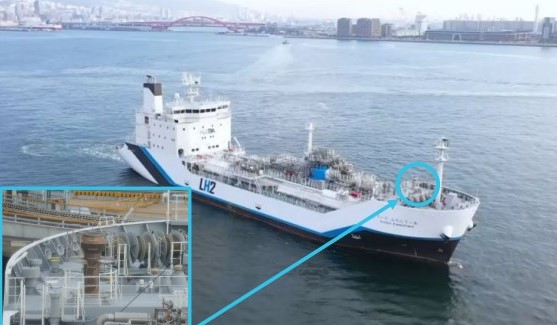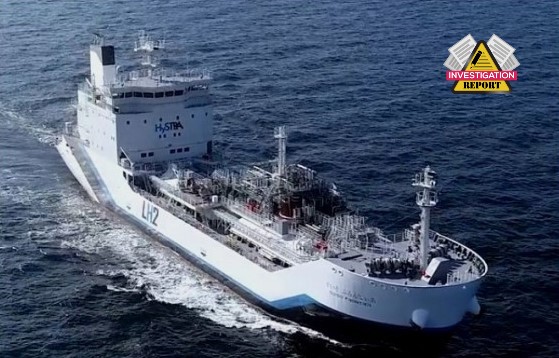The Australian Transport Safety Bureau (ATSB) published its investigation report on the liquified hydrogen (LH2) carrier Suiso Frontier. According to the report, the failure of an incorrectly-fitted electrical solenoid valve led to the brief propagation of flame.
The incident
At 1330 Eastern Standard Time1 on 20 January 2022, the liquified hydrogen (LH2) tanker, Suiso Frontier, berthed at Bluescope berth number 2 in the Port of Hastings, Victoria. The ship was on its maiden voyage, having departed Kobe, Japan on 25 December with 55 t of LH2, loaded for the purpose of testing its cargo and monitoring systems. The ship was to load additional LH2 from the gas liquefaction facility at Hastings for Kobe, as part of a pilot program associated with the carriage of LH2 by sea.
After 3 days of preparation, the transfer of LH2 to Suiso Frontier began at 0715 on 24 January. The transfer was completed by 1500 that day, with the ship scheduled to depart on 27 January.
While berthed on the evening of 25 January, the chief mate and cargo engineer made plans to start the ship’s gas combustion unit or GCU (see the section titled Gas combustion unit and Figure 1) to burn excess boil-off gas (BOG) from the LH2 cargo tank. 2 They notified the wharf operator and followed standard procedures for preparing the GCU, including conducting required safety checks. The ship was equipped with 2 radial fans to supply combustion, cooling and dilution air to the GCU, and fan number 1 was pre-selected for use.

At 1947, the chief mate and cargo engineer initiated the starting sequence of the GCU from the unit’s compartment in the ship’s forecastle space. The unit’s control system then performed a series of automated function tests to ensure the correct parameters were present for stable hydrogen combustion. By 2007, the GCU was in operation.
Over the next 8 minutes, the cargo engineer gradually increased the hydrogen flow until the maximum combustion rate of 40 kg of hydrogen per hour was reached. All GCU parameters and temperatures were observed to be within their normal range. Meanwhile, the third mate had started their watch and was assigned to monitor the GCU from the cargo control room (CCR).
At about 2147, an able seaman (AB) was conducting routine safety rounds on deck when they saw a 1 m high yellow flame propagate for about 5 seconds from the GCU vent stack on the port side of the ship’s foredeck (Figure 2). The AB immediately notified the third mate in the CCR via handheld radio. Seconds later, the GCU flue gas temperature reached 450°C, triggering the high flue gas temperature and common alarms in the CCR. The third mate quickly shut down the GCU and closed its main hydrogen supply valve. After confirming with the AB that there was no flame from the vent stack, the third mate telephoned the chief mate, master and cargo engineer.
When the chief mate arrived in the CCR, the GCU was going through its programmed shutdown sequence. When the GCU stopped at 2149, the chief mate ventured out on deck to investigate. Moments later, the master arrived in the CCR and was informed that the GCU had been stopped and inspections were underway. The master then proceeded to the bridge, raised the fire alarm and used the ships public address system to make an announcement to muster the crew. Crew members promptly responded, mustering at their emergency stations and began preparing fire hoses as per standard procedures.
Meanwhile, the chief mate was joined by the cargo engineer on deck where they inspected the GCU and adjacent compartments. They closed additional gas valves to isolate the GCU and checked temperatures with an infrared thermometer. While temperatures around the GCU vent stack appeared to be abnormally high at 160-180°C, there were no significant hot spots or signs of fire.
At 2249, after confirming that the temperature of the GCU was steadily decreasing, the master determined that there was no risk of fire and stood down the crew. As a precaution, regular inspections of the GCU were carried out throughout the rest of the evening.

Analysis
#1 Failure of damper actuator solenoid
The solenoid valves installed on the gas combustion unit’s air fan discharge damper actuators were of the incorrect specification.
Due to the mismatched specifications between the 24 V DC solenoid valves and the control system’s 230 V AC power supply, the solenoid valves had been subjected to damaging vibrations and high temperatures during operation. After a relatively short 400-hour service life, one of the solenoids eventually failed at the time of the incident, most probably due to overheating and material fatigue, leading to a short circuit or functional fault.
#2 Closing of vent damper
Following the failure of the damper actuator solenoid valve during GCU operation, the damper closed, significantly restricting air supply to the GCU for combustion, cooling and dilution.
Due to the wide flammability range of hydrogen gas, enough air remained within the GCU to support combustion of the gas for several minutes after the damper closed. However, as the airflow for cooling and dilution was significantly restricted by the closed damper, temperatures in the GCU began to rise. Following the restriction of air to the GCU, the hydrogen flame gravitated towards the ambient air outside of the vent. As the flame rose up from the vent, it probably reacted with sodium chloride (salt from the environment at sea) ingrained on the inner flue surfaces resulting in the yellow flame that the AB reported.
#3 Gas combustion unit design
The GCU’s safety systems did not detect and respond to the malfunction in time to prevent the hydrogen flame propagating from the vent stack.
The manufacturer’s failure mode and effect analysis (FMEA) predicted that, in the event of the damper closing during operation, the GCU’s 2 flame scanners would detect the resulting instability of the hydrogen flame and shut down the GCU. However, when the damper closed, the scanners did not detect any abnormality despite the hydrogen flame transitioning out of the vent stack.
The GCU was not equipped to detect the failure of the vent damper solenoid valve or the subsequent closing of the damper. A low air pressure transmitter was fitted to the GCU but was located between the fan and the damper. As a result, it did not activate when the damper closed since the air pressure on the fan side of the damper did not drop.
Probable cause
- An incorrect type of solenoid valve had been installed on the pneumatic damper actuators for the gas combustion unit’s (GCU) 2 air fans. The 24 V direct current solenoid valves installed were incompatible with the system’s 230 V alternating current power supply.
- During operation of the GCU, the fan discharge damper providing combustion, dilution and cooling air closed when the damper’s actuator solenoid valve failed. Consequently, the temperature in the GCU increased, making the hydrogen flame unstable, which then propagated from the unit’s vent stack on the ship’s deck.
- The GCU was not equipped to detect an air damper closing during operation, and its flame scanners were ineffective in detecting the abnormal condition as per the manufacturer’s risk assessment. As a result, the GCU alarm and shut-down mechanisms did not activate in time to prevent the flame propagating from the vent on deck.
Safety action
On 12 October 2022, Saacke advised the ATSB that it has installed limit switches to the gas combustion unit’s air fan discharge dampers as agreed with the Suiso Frontier’s manager, Shell International Trading and Shipping Company. The limit switches are designed to monitor the position of the dampers and the system’s control logic has been programmed to automatically stop the GCU if an ‘open’ signal from the dampers is not detected. The modifications were confirmed to be functioning as designed and approved by the ship’s classification society.






























































